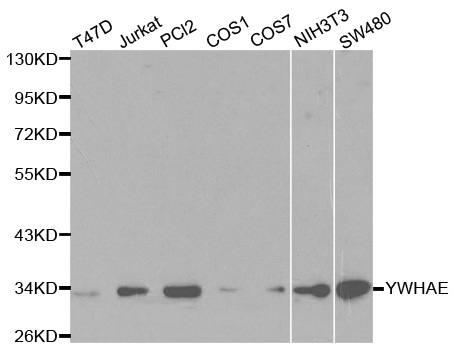14-3-3 epsilon (YWHAE) Rabbit Polyclonal Antibody
CAT#: TA326903
Rabbit anti-YWHAE Polyclonal Antibody
Need it in bulk or conjugated?
Get a free quote
![]() 热销推荐
热销推荐
CNY 1,999.00
CNY 2,700.00
CNY 3,080.00
CNY 300.00
CNY 1,430.00
CNY 2,900.00
CNY 6,650.00
CNY 9,998.00
Specifications
| Product Data | |
| Applications | ICC/IF, WB |
| Recommend Dilution | WB 1:500 - 1:2000;IF 1:20 - 1:100 |
| Reactivity | Human, Mouse, Rat |
| Host | Rabbit |
| Clonality | Polyclonal |
| Immunogen | Recombinant protein of human YWHAE |
| Formulation | Store at -20C or -80C. Avoid freeze / thaw cycles. Buffer: PBS with 0.02% sodium azide, 50% glycerol, pH7.3 |
| Concentration | lot specific |
| Purification | Affinity purification |
| Conjugation | Unconjugated |
| Storage Condition | Store at -20°C as received. |
| Predicted Protein Size | 29 kDa |
| Gene Name | tyrosine 3-monooxygenase/tryptophan 5-monooxygenase activation protein epsilon |
| Database Link | |
| Background | The 14-3-3 family of proteins plays a key regulatory role in signal transduction, checkpoint control, apoptotic and nutrient-sensing pathways. 14-3-3 proteins are highly conserved and ubiquitously expressed. There are at least seven isoforms, β, ?, e, s, ?, t, and ? that have been identified in mammals. The initially described a and d isoforms are confirmed to be phosphorylated forms of β and ?, respectively. Through their amino-terminal a helical region, 14-3-3 proteins form homo- or heterodimers that interact with a wide variety of proteins: transcription factors, metabolic enzymes, cytoskeletal proteins, kinases, phosphatases, and other signaling molecules. The interaction of 14-3-3 proteins with their targets is primarily through a phospho-Ser/Thr motif. However, binding to divergent phospho-Ser/Thr motifs, as well as phosphorylation-independent interactions, has been observed. 14-3-3 binding masks specific sequences of the target protein and therefore modulates target protein localization, phosphorylation state, stability, and molecular interactions. 14-3-3 proteins may also induce target protein conformational changes that modify target protein function. Distinct temporal and spatial expression patterns of 14-3-3 isoforms have been observed in development and in acute response to extracellular signals and drugs, suggesting that 14-3-3 isoforms may perform different functions despite their sequence similarities. Several studies suggest that 14-3-3 isoforms are differentially regulated in cancer and neurological syndromes. |
| Synonyms | 14-3-3E; HEL2; KCIP-1; MDCR; MDS |
| Reference Data | |
| Protein Families | Druggable Genome |
| Protein Pathways | Cell cycle, Neurotrophin signaling pathway, Oocyte meiosis |
Documents
| Product Manuals |
| FAQs |
| SDS |
Resources
| 抗体相关资料 |
其它14-3-3 epsilon产品


 United States
United States
 Germany
Germany
 Japan
Japan
 United Kingdom
United Kingdom
 China
China

